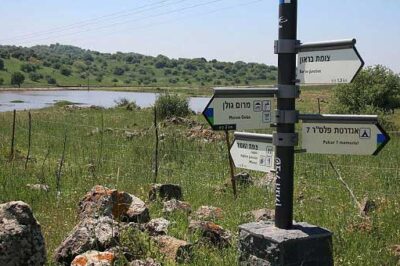It is very rare that I visit a site in this tiny country that I have never visited before, but recently I had the awesome privilege of overlooking the Valley of Quneitra into Syria from Mount Bental.
From there, you can see the border with Syria, and nothing can highlight the differences between the two countries like the fact that on the Israeli side, everything is green and plush, and on the Syrian, it appears to be a barren wasteland.
On Top of Mount Bental
Mount Bental was the location of one of the biggest tank battles in history—during the 1973 Yom Kippur War. The Quneitra (pronounced koo-net-tra) Valley is called the Valley of Tears because of massive loss of life that took place there.
The Golan Heights is an immense, hilly plateau in Northern Israel. It borders Syria, Jordan and Lebanon. Its average height is about 3,500 feet. Its highest point on the northern border of Mount Hermon tops 9,000 feet.
Syria Terrorizes Israel From the Highlands
When Syria controlled this region, she used the highland to rain terror on Israel’s Galilee villages and farms with rockets and bombs, and PLO raids were launched against Israel from Syrian territory. Syria’s attacks grew more frequent in 1965 and 1966. Often, Israeli children would have to sleep in bomb shelters. A final attack was unleashed against defenseless Israeli towns in April 1967. Israel responded by shooting down six Syrian MiG fighter jets and issued a stern warning.
In addition, Syria was seeking to divert water from entering the Sea of Galilee—Israel’s main supply of drinking water. A country can’t last long without water. This, in and of itself, was an act of war.
Having had enough, Israel defended herself in the Six Day War, fighting—literally—an uphill battle. Israeli tanks stormed the Golan Heights and fought a bloody, intense battle. Israeli causalities reached 115 in just a few days, while Syrian casualties were 20 times that, at 2,500. In the end, Israel controlled the highlands.
Peace Rejected by Syria
It is important to note that just a few days later, on June 19, 1967, the prime minister and his cabinet voted to return the Golan Heights to Syria in exchange for a peace treaty. Disgraced, Syria would not be further humiliated and rejected the olive branch.
Attacked While Fasting
In 1973, as the entire country of Israel was fasting for Yom Kippur, a humiliated Arab world (from the Six Day War defeat) led by Egypt and Syria attacked Israel. The surprise attack caught Israel off guard. My wife remembers her brother being called out of the synagogue to report for duty, along with tens of thousands of soldiers and reservists.
However, initial gains by Syria proved fleeting. Once the reserves were organized, they launched a counter-offensive, regaining all the territory. In fact, by the end of the short war, Israeli shells were reaching the outskirts of the Syrian capital Damascus. Israeli troops extended their reach 20 kilometers into Syria!
Peace Agreement?
Several attempts from Syria to retake this land were rebuffed by Israel. Finally in May 1974, Israel and Syria signed a Separation of Forces agreement. Israel retreated to the Golan Heights, and Syria reoccupied areas lost in the Yom Kippur war. Again, just to be clear, Israel did not relinquish the Golan Heights, just the areas gained in 1973. There would be a demilitarized zone in between the two countries that would be occupied by U.N. peacekeepers, the United Nations Disengagement Observer Force.
After 40 Years, Peacekeepers Run
Amazingly the view atop Mount Bental has been Israel’s quietest border until the recent Syrian civil war. Recently Austria pulled its 377 troops (out of 911) from the mission, after Syrian rebels briefly overtook the border crossing at Quneitra.
This is not the first time a U.N. peacekeeping mission abandoned its post on Israel’s border. Leading up to the Six Day War, President Nasser of Egypt ordered the U.N.—what was then considered to be their great peacekeeping mission—to leave the Sinai Peninsula, where they served as a buffer between Israel and Egypt. And without a word of dissent, they left.
From my vantage point yesterday, high on Mount Bental I could see the U.N. outpost where rebel forces kidnapped 21 unarmed U.N. Filipino peacekeepers. I could also see smoke billowing out of New Quneitra—and I could not determine if it was the result of a rocket or some Arab burning trash. New Quneitra has been the scene of several bloody battles in recent months.
Syria abandoned Old Quneitra after Israel retuned the land in May 1974 and simply built a new city close by. Old Quneitra now serves as a reminder that Israel, while desiring peace with her neighbors, is willing to defend itself against attack.
Ron Cantor is the director of Messiah’s Mandate International in Israel, a Messianic ministry dedicated to taking the message of Jesus from Israel to the ends of the earth (Acts 1:8). Cantor also travels internationally teaching on the Jewish roots of the New Testament. He serves on the pastoral team of Tiferet Yeshua, a Hebrew-speaking congregation in Tel Aviv. His newest book, Identity Theft, was released April 16. Follow him at @RonSCantor on Twitter.
For the original article, visit messiahsmandate.com.








Leave a Comment
You must be logged in to post a comment.